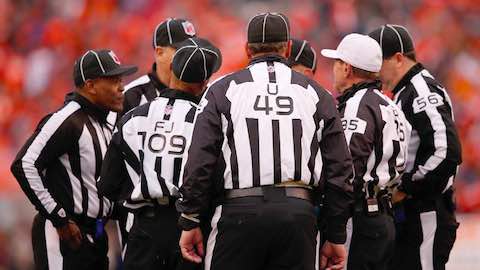- MENU
- HOME
- SITE
- WORLD
- MAIN
- AFRICA
- ASIA
- BALKANS
- EUROPE
- LATIN AMERICA
- MIDDLE EAST
- United Kingdom
- United States
- Argentina
- Australia
- Austria
- Benelux
- Brazil
- Canada
- China
- France
- Germany
- Greece
- Hungary
- India
- Indonesia
- Ireland
- Israel
- Italy
- Japan
- Korea
- Mexico
- New Zealand
- Pakistan
- Philippines
- Poland
- Russia
- South Africa
- Spain
- Taiwan
- Turkey
- USA
- BUSINESS
- WEALTH
- STOCKS
- TECH
- HEALTH
- LIFESTYLE
- ENTERTAINMENT
- SPORTS
- RSS
- iHaveNet.com: NFL Football

NFL 2017: New NFL Rules For 2017
Here are the rules changes for the NFL 2017 season
Unsportsmanlike Conduct Fouls
Makes permanent the rule that automatically disqualifies a player that is penalized twice in the same game for certain types of unsportsmanlike conduct fouls. These types of fouls include:
- Throwing a punch or kick without making contact
- Use of abusive or threatening language
- Any act that constitutes taunting
Additionally, it is now an unsportsmanlike conduct penalty to commit multiple fouls during the same down designed to manipulate the game clock.
Replay Reviews
All sideline replay monitors will be replaced with a hand-held device and designated members of the NFL Offi ciating department will be authorized to make the final decision on replay reviews from the NFL league office.
Leaping
Prohibits a player who is off the line of scrimmage from running and jumping over offensive lineman on the line of scrimmage in an attempt to block a FG or PAT attempt.
Touchbacks
For the 2017 season, after a touchback resulting from a kickoff or safety kick, the ball will be placed at the receiving team's 25-yard line. The rule, which was also used in the 2016 season, was approved on a one-year basis for 2017.
Crackback Blocks
Prohibits crackback blocks by a backfi eld player in motion, even if he is not more than two yards outside the tackle when the ball is snapped.
Defenseless Receiver Protection
Gives a receiver running a pass route defenseless player protection when the defender approaches him from behind or the side.
Overtime
The length of preseason and regular season overtime periods is reduced from 15 minutes to 10 minutes.
Clock Stoppages
All illegal acts to conserve time are not permitted after the two-minute warning of either half. The previous rule applied inside of one minute of either half.
There will also be points of emphasis on several existing rules this season (although the rules themselves have not changed):
Game officials, and especially referees, will continue to enforce the rules that protect the quarterback from forcible contact in the knee area or below. Driving the helmet, shoulder, forearm or chest into the quarterback in the knee area or below will be a foul. The onus is on the defender to avoid this type of contact whenever possible. This will be called even if the defender uses his arm or arms to wrap. The defender must use his arm or arms to swipe or grab the lower leg of the passer to tackle him legally. If the defender is thrown, pushed or fouled into the knee area and the contact is unavoidable, there is no foul. Once the quarterback tucks the ball and takes a running posture or moves outside of the pocket and throws on the run, he no longer receives protection from low hits.
Blindside blocks will continue to be strictly enforced. Anytime a blocker is moving toward his own endline, he cannot block an opponent in the head or neck area. When moving in this direction, the legal target area is above the waist and below the neck.
Launching and hits away from the play are two more points of emphasis for 2017. It is illegal for a player to leave both feet before making forcible contact with any part of his helmet to any part of a defenseless player's body. In addition, game officials will pay close attention to unnecessary hits away from the fl ow of the play.
Contact downfi eld between receivers and defenders will continue to be a point of emphasis as the Competition Committee looks to further clarify the rules involving pass interference, defensive holding and illegal contact. Game officials will pay particular attention to actions coming off the line of scrimmage and at the top of routes. This includes a defensive player grabbing a receiver or a receiver pushing off to create space or grabbing and pulling the defender to get open.
Receive our NFL News & Analysis by email by subscribing here
NFL Super Bowl History
NFL Super Bowl History, Scores, Summaries & Super Bowl MVP Articles
NFL Football: "NFL 2017: New NFL Rules For 2017"